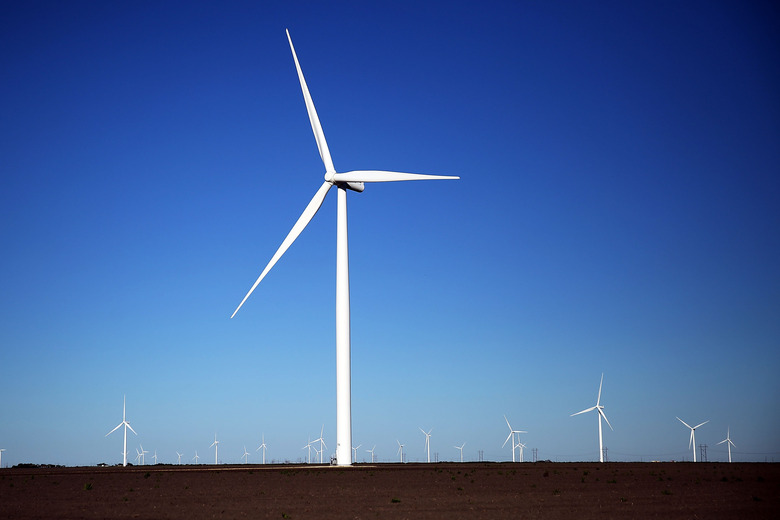How Much Power Does A Wind Turbine Generate?
Wind turbines are capable of spinning their blades on hillsides, in the ocean, next to factories and above homes. The idea of letting nature provide free power to your home may seem appealing, but it's important to learn how to compute wind turbine output before buying one — and particularly important to understand the difference between the rated capacity of the machine and the actual output you can expect from it. Check the wind maps provided by National Renewable Energy Laboratory to learn whether wind speed and availibility in your area makes wind energy a good choice for your home.
Wind Speed
Wind Speed
Most wind turbines are made up of rotor-mounted blades that resemble airplane propellers. When air blows through them, they cause the rotor to turn a shaft that powers an electrical generator. Most turbines automatically shut down when wind speeds reach about 88.5 kilometers per hour (55 miles per hour) to prevent mechanical damage. This reduces electricity production when high winds occur and people need continuous power from the wind. They also don't produce electricity if the wind is blowing too slowly. If the wind speed decreases by half, power production decreases by a factor of eight. The time during which wind conditions are optimal in a given region define the wind turbine's availability. Turbines located at higher locations receive more wind, which translates into greater output. Each one has a wind speed range — between 30 and 50 miles per hour — at which it operates optimally.
Efficiency Rating
Efficiency Rating
Modern wind turbines use a variety of designs intended to help them capture wind more efficiently. Efficiency is an important value to know when assessing a wind turbine. In an ideal world, a turbine would convert 100 percent of wind passing through the blades into power. Because of factors such as friction, these machines only have efficiency ratings of between 30 percent and 50 percent of rated power output. Power output is calculated as follows:
\(\text{power}=\frac{\text{air density}\times \text{swept area of blades}\times \text{wind speed}^3}{2}\)
The area is in meters squared, air density is in kilograms per meters cubed and wind speed is in meters per second.
Critical Distinctions
Critical Distinctions
Just because a wind turbine has a capacity rating of 1.5 megawatts, that doesn't mean it will produce that much power in practice. Wind turbines commonly produce considerably less than rated capacity, which is the maximum amount of power it could produce if it ran all the time. For example, a 1.5-megawatt wind turbine with an efficiency factor of 33 percent may produce only half a megawatt in a year — less if the wind isn't blowing reliably. Industrial scale turbines usually have capacity ratings of 2 to 3 megawatts. However, the amount of energy actually produced is reduced by efficiency and wind availability — the percentage of time a unit has enough wind to move.
Wind Turbine Shopping Tips
Wind Turbine Shopping Tips
If you know a unit's capacity and efficiency factors, you can compute its estimated annual output using the following formula:
\(365\frac{\text{days}}{\text{year}}\times 24\frac{\text{hours}}{\text{days}}\times \text{maximum capacity}\times \text{capacity factor}=\text{kilowatt hours per year}\)
For example, a turbine with a rated capacity of 1.5 megawatts and efficiency factor of 25 percent would be expected to produce as follows:
\(365\times 24\times 1500\times 0.25 = 3,285,000\text{ kilowatt hours per year}\)
This calculation assumes wind availability at 24 hours a day all year around. In practical application, this doesn't happen. You can use the NREL wind maps to adjust your time figures for a more accurate location-specific figure.
Cite This Article
MLA
Lee, Kevin. "How Much Power Does A Wind Turbine Generate?" sciencing.com, https://www.sciencing.com/much-power-wind-turbine-generate-6917667/. 8 November 2020.
APA
Lee, Kevin. (2020, November 8). How Much Power Does A Wind Turbine Generate?. sciencing.com. Retrieved from https://www.sciencing.com/much-power-wind-turbine-generate-6917667/
Chicago
Lee, Kevin. How Much Power Does A Wind Turbine Generate? last modified March 24, 2022. https://www.sciencing.com/much-power-wind-turbine-generate-6917667/
